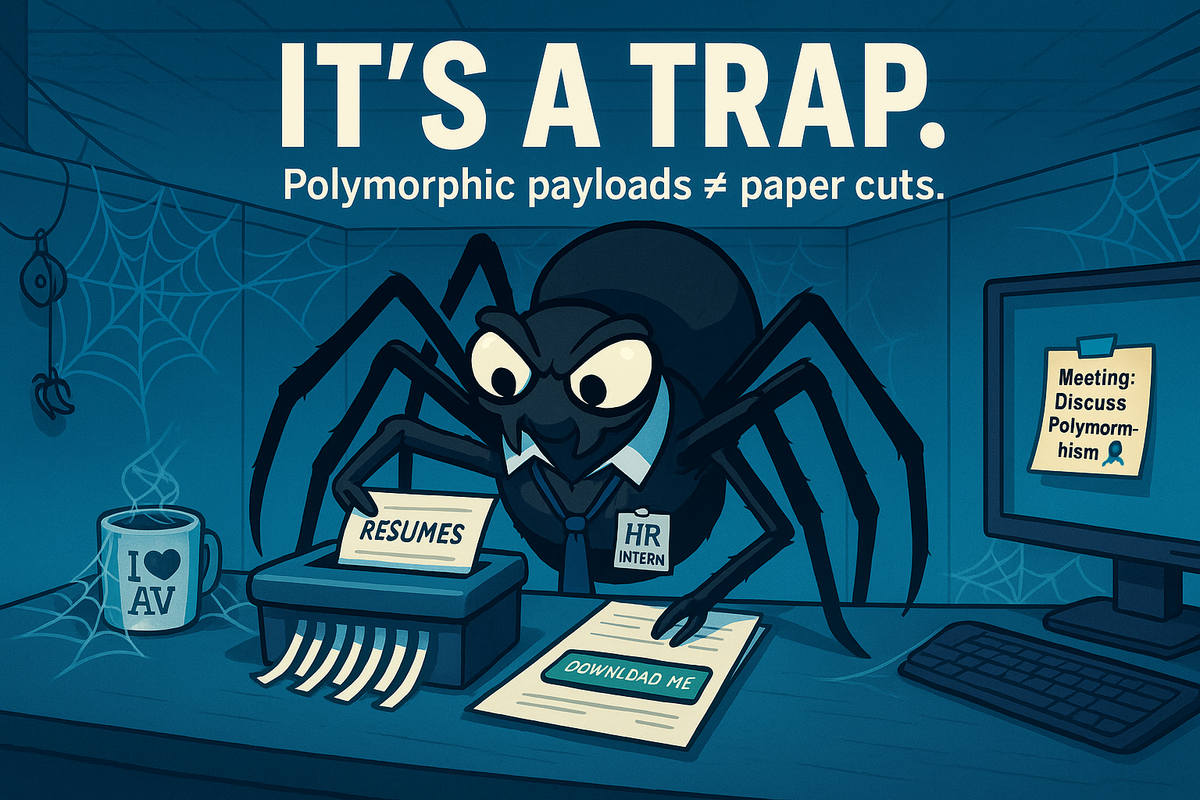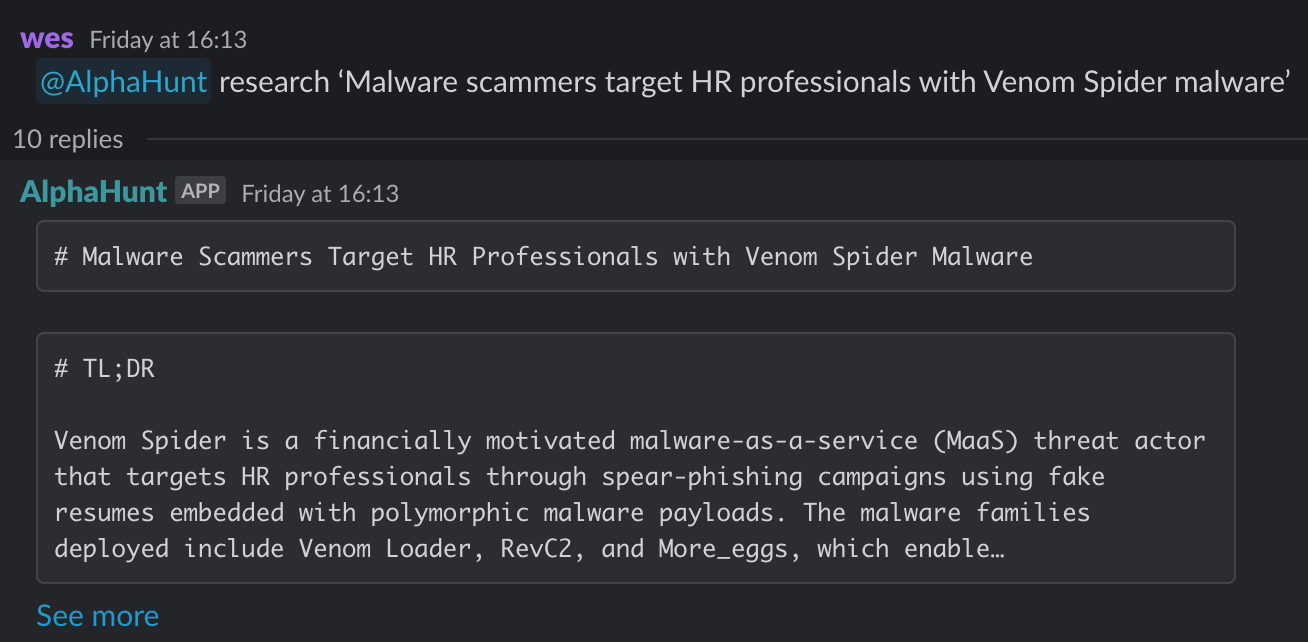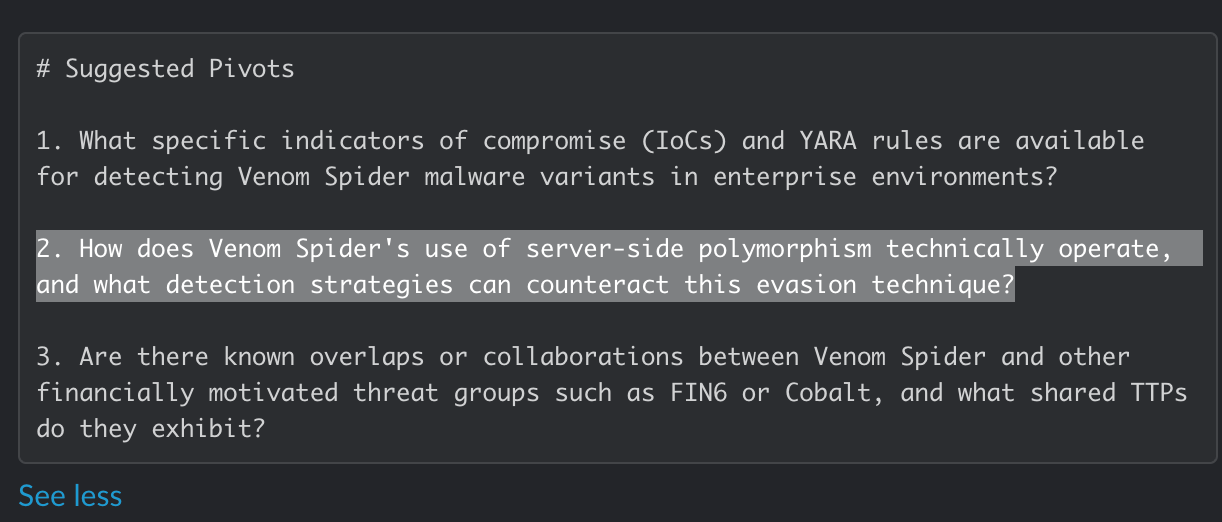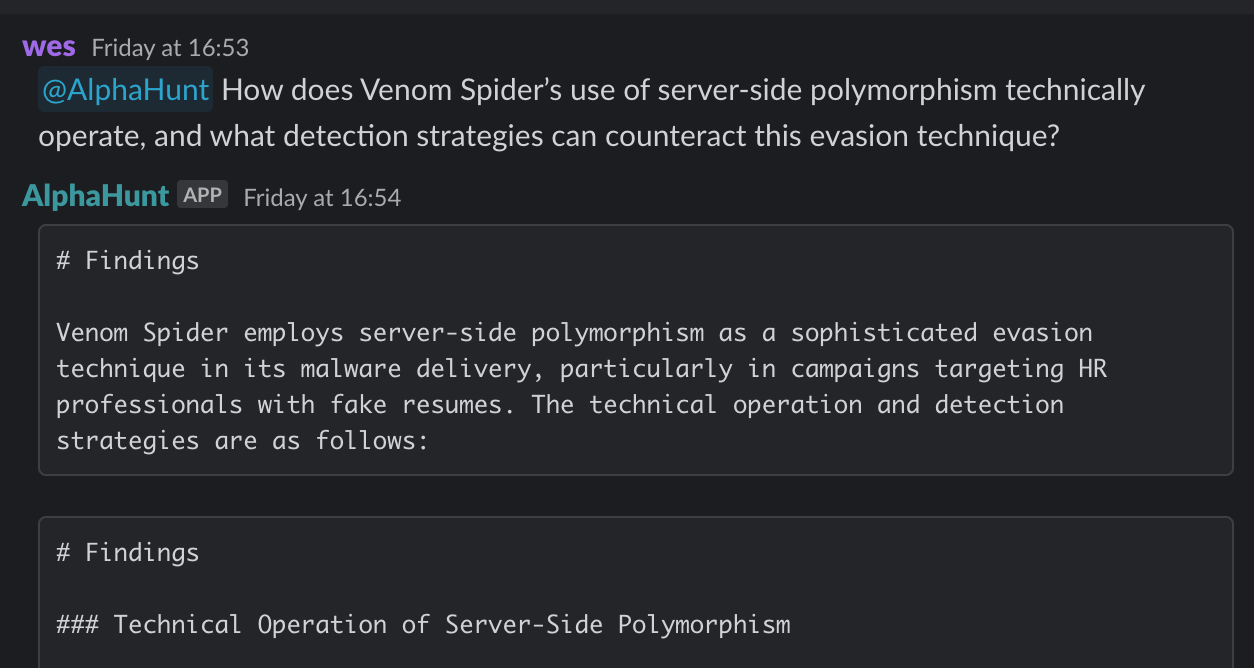Venom Spider’s Polymorphic More_eggs: Advanced HR-Targeted Intrusions and Evasion Tactics
Venom Spider (TA4557) is a financially motivated cybercriminal group specializing in spear-phishing campaigns against HR professionals, primarily in the U.S., U.K., Canada, Australia, and Germany. Their attacks exploit the HR function’s need to process external attachments..




(Have feedback? Did something resonate with you? Did something annoy you? Just hit reply! :))
Get questions like this:
- research ‘Malware scammers target HR professionals with Venom Spider malware’
- How does Venom Spider’s use of server-side polymorphism technically operate, and what detection strategies can counteract this evasion technique?
Does it take a chunks out of your day? Would you like help with the research?
This baseline report was thoughtfully researched and took 10 minutes.. It's meant to be a rough draft for you to enhance with the unique insights that make you an invaluable analyst.
We just did the initial grunt work..
Are you ready to level up your skillset? Get Started Here!
Did this help you? Forward it to a friend!
Suggested Pivot
How can Endpoint Detection and Response (EDR) telemetry, including logs of .lnk file executions, living-off-the-land utility usage (e.g., ie4uinit.exe, msxsl.exe), and time-delayed script activity, be analyzed to develop behavioral detection rules specifically tailored to identify Venom Spider’s polymorphic More_eggs malware in HR environments? What recent case studies or incident reports demonstrate successful or failed detection using these methods?
TL;DR
Key Points
-
- Venom Spider (TA4557) is actively targeting HR departments with spear-phishing campaigns delivering polymorphic More_eggs malware via fake resumes.
- HR professionals are high-risk due to operational necessity to open attachments from unknown sources.
-
- The group leverages server-side polymorphism, generating unique malware payloads per victim to evade signature-based and sandbox detection.
- Traditional AV and sandboxing are largely ineffective; behavioral analytics and EDR are required.
-
- Living-off-the-land (LotL) techniques are used, abusing legitimate Windows binaries (ie4uinit.exe, msxsl.exe) for stealthy execution and persistence.
- Detection must focus on anomalous LotL binary usage and .lnk file executions.
-
- Documented breaches in 2024–2025 resulted in theft of credentials, employee records, and sensitive corporate data, with prolonged undetected access.
- Early detection and network segmentation are critical to limit impact.
-
- Multi-layered defense is essential: EDR, Secure Email Gateways, targeted HR security training, network segmentation, and real-time IOC integration.
- Incident response plans must be tailored and regularly rehearsed for polymorphic malware scenarios.
Executive Summary
Venom Spider (TA4557) is a financially motivated cybercriminal group specializing in spear-phishing campaigns against HR professionals, primarily in the U.S., U.K., Canada, Australia, and Germany. Their attacks exploit the HR function’s need to process external attachments, delivering polymorphic More_eggs backdoor malware via fake resumes hosted on actor-controlled sites. Each payload is uniquely generated server-side, employing advanced obfuscation and evasion, including CAPTCHA-protected delivery and living-off-the-land execution using Windows utilities like ie4uinit.exe and msxsl.exe.
The More_eggs backdoor enables credential theft, data exfiltration, command execution, and persistence, with server-side polymorphism rendering traditional signature-based detection ineffective. Documented incidents in 2024–2025 show successful breaches of HR, legal, and financial services organizations, resulting in significant data loss and prolonged attacker presence.
Effective defense requires a multi-layered approach: deploying and tuning EDR for behavioral detection, enhancing email security with SEG and sandboxing, conducting scenario-based HR security training, segmenting HR networks, integrating real-time threat intelligence, and rehearsing incident response. The threat landscape is expected to evolve, with Venom Spider and similar actors likely to adopt AI-driven polymorphism and target less-hardened organizations as defenses improve. Cross-sector intelligence sharing and sector-specific playbooks are recommended to stay ahead of these advanced, evasive campaigns.
Research & Attribution
Origin
Venom Spider (also known as TA4557) is a financially motivated cybercriminal group that has actively targeted corporate Human Resources (HR) departments and recruiters since at least 2023. Their campaigns use spear-phishing emails containing links to fake resumes hosted on actor-controlled websites. These resumes deliver polymorphic malware payloads, notably the More_eggs backdoor, which is dynamically generated server-side to evade detection. The group abuses legitimate job platforms and messaging services to submit malicious job applications, exploiting the operational necessity of HR professionals to open attachments from unknown sources.
Motivation
Venom Spider’s primary motivation is financial gain through credential theft, data exfiltration, and espionage. By targeting HR professionals, they gain access to sensitive employee data, corporate strategic information, intellectual property, and customer payment data. This information can be monetized or used for further intrusion and lateral movement within victim organizations.
Historical Context
Polymorphic malware has long been used to evade signature-based detection by changing its code with each infection. Venom Spider’s use of server-side polymorphism represents an advanced evolution, where the malware payload is uniquely generated on the attacker’s server for each victim, making detection by traditional antivirus and sandboxing tools extremely difficult. This tactic aligns with a broader trend of cybercriminals exploiting HR departments, which are often less hardened and regularly interact with external contacts, making them ideal initial access points.
Timeline
- October 2023: Venom Spider escalates targeting of HR professionals with spear-phishing campaigns.
- Late 2024: Multiple incidents reported involving polymorphic More_eggs backdoor delivered via fake resumes.
- May 2025:
- Arctic Wolf Labs publishes technical analysis of Venom Spider’s server-side polymorphism and More_eggs malware.
- Tanium and other CTI teams report ongoing campaigns targeting U.S. HR departments and recruiters.
Countries Targeted
- United States – Primary focus on HR professionals in corporate, legal, and financial sectors.
- Canada – Secondary targeting in North America.
- United Kingdom – Targeting financial and professional services sectors.
- Australia – Limited targeting in professional services.
- Germany – Occasional targeting in multinational organizations.
Sectors Targeted
- Human Resources – Direct targeting of HR professionals and recruiters.
- Legal Firms – Targeted for access to sensitive case and personnel information.
- Financial Services – Targeted for access to financial data and employee credentials.
- Healthcare – Targeted for access to patient and staff records.
- Technology – Targeted for intellectual property and employee data.
Links to Other Malware
Venom Spider campaigns are linked to the More_eggs backdoor malware family, which uses server-side polymorphism to generate unique JavaScript payloads and obfuscated executable libraries. The More_eggs backdoor supports credential theft, data exfiltration, command execution, and persistence. The malware uses living-off-the-land techniques by leveraging legitimate Windows utilities such as ie4uinit.exe and msxsl.exe to evade detection.
Similar Malware
Similar polymorphic malware campaigns include those by threat actors such as Luna Moth and StealC V2, which also employ advanced obfuscation, encryption (e.g., RC4), and server-side payload generation to evade detection. These campaigns similarly target professional sectors using spear-phishing and social engineering.
Threat Actors
Venom Spider (TA4557) is a financially motivated cybercriminal group with advanced capabilities in social engineering, malware obfuscation, and server-side polymorphism. They focus on HR and recruitment professionals to gain initial access and maintain persistence within victim networks.
Breaches Involving This Malware
- Multiple documented incidents in 2024–2025 where Venom Spider delivered More_eggs malware via fake job applications to HR departments in U.S. companies, resulting in theft of employee records, credentials, and sensitive corporate data.
- Campaigns have evaded traditional detection due to server-side polymorphism and living-off-the-land techniques, leading to prolonged undetected access.
Explanation of Server-Side Polymorphism in Venom Spider Campaigns
Server-side polymorphism is a technique where the malware payload is dynamically generated and uniquely altered on the attacker’s server each time it is requested or downloaded by a victim. This means every copy of the malware is different in code structure, size, and obfuscation, though functionally identical. For Venom Spider, this technique is used to evade signature-based detection systems and sandbox analysis.
In Venom Spider’s campaigns, the attack begins with a spear-phishing email containing a link to a fake resume hosted on an actor-controlled website. When the victim clicks the link and passes a CAPTCHA (used to bypass automated scanners), a ZIP file is downloaded containing a malicious Windows shortcut (.lnk) file and a decoy image. The .lnk file is uniquely generated for each download with different obfuscation and file size, embodying server-side polymorphism.
When the .lnk file is opened, it executes an obfuscated batch script that launches legitimate Windows utilities (e.g., WordPad as a distraction and ie4uinit.exe to execute commands) to run a polymorphic JavaScript payload called More_eggs_Dropper. This payload generates further polymorphic JavaScript code and executable libraries on the victim’s system, which then establish command-and-control (C2) communications and enable data theft and persistence.
Analogy: Like a chameleon changing its colors to avoid predators, Venom Spider’s malware changes its “appearance” with each delivery, making it difficult for security tools to recognize and block it.
Practical Detection Methodologies
A multi-layered approach is recommended for HR departments and organizations to detect and mitigate Venom Spider’s polymorphic malware campaigns:
-
Behavioral Monitoring and Endpoint Detection:
- Deploy Endpoint Detection and Response (EDR) solutions capable of detecting anomalous behaviors such as unexpected execution of .lnk files, use of living-off-the-land utilities (ie4uinit.exe, msxsl.exe), and unusual network connections.
- Monitor for time-delayed execution patterns and obfuscated script activity.
-
Email Security Enhancements:
- Implement Secure Email Gateway (SEG) solutions configured to block or quarantine risky file types commonly used in these campaigns (.lnk, .vbs, .iso, .zip).
- Use sandboxing with advanced evasion detection to analyze attachments and links dynamically.
- Enable phishing report buttons to empower HR staff to report suspicious emails quickly.
-
User Awareness and Training:
- Conduct regular security awareness training tailored for HR professionals, emphasizing the risks of opening unsolicited attachments and links, especially from unknown job applicants.
- Train staff to inspect file properties before opening and to be wary of password-protected attachments.
-
Network Segmentation and Access Controls:
- Segment HR systems from other critical network segments to limit lateral movement.
- Enforce least privilege access policies on HR workstations.
-
Threat Intelligence and IOC Integration:
- Integrate updated threat intelligence feeds containing Venom Spider’s indicators of compromise (IOCs), including hashes of polymorphic payloads and C2 domains.
- Regularly review logs for signs of communication with known malicious infrastructure.
-
Incident Response Preparedness:
- Develop and rehearse incident response plans specific to phishing and polymorphic malware infections.
- Establish clear workflows for HR and IT teams to handle suspicious emails and potential compromises.
Real-Life Case Studies / Incident Examples
-
Arctic Wolf Labs (May 2025) documented a campaign where Venom Spider targeted U.S.-based corporate HR departments and recruiters. The attack used spear-phishing emails with links to fake resumes hosted on actor-controlled sites requiring CAPTCHA verification. The downloaded ZIP files contained polymorphic .lnk files that executed obfuscated batch scripts leveraging living-off-the-land techniques. The More_eggs backdoor was deployed, capable of stealing credentials, customer payment data, intellectual property, and trade secrets. The campaign used server-side polymorphism to generate unique payloads for each victim, evading signature-based detection. Indicators of compromise (IOCs) and MITRE ATT&CK techniques were published to aid detection and remediation.
-
A U.S. legal firm reported a breach in late 2024 where HR staff received spear-phishing emails with fake resumes containing polymorphic malware. The malware evaded traditional detection and established a persistent backdoor, leading to theft of employee personal data and internal communications. The attack leveraged living-off-the-land utilities and time-delayed execution to avoid sandbox analysis.
-
Trend Micro and other cybersecurity firms reported ongoing campaigns delivering More_eggs malware via fake job applications targeting HR departments in multinational financial services companies. Detection occurred only after unusual outbound network traffic was identified by behavioral analytics tools.
Recommendations, Actions, Suggested Pivots, Forecasts and Next Steps..
(Subscribers Only)





